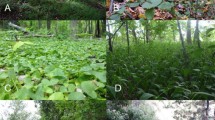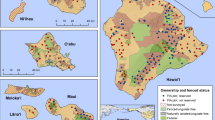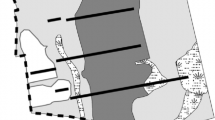Abstract
Invasions of alien plants pose a serious threat to native biodiversity and ecosystem processes. Forests are considered more resistant to invasion due to limited light availability in understories. However, disturbance and abiotic stress may open tree canopies and promote invasion. Their combined effects together with the resistance of resident species may determine the numbers and abundances of invasive species. Here we explore how canopy openness, water stress, and taxonomic and functional properties of resident communities affect the invasion by a frequent single invasive species (Aster lanceolatus and Impatiens parviflora) compared to that by multiple invaders in Central European lowland forests. Different abiotic factors and species-specific mechanisms of invasiveness determined the success of single versus multiple invaders. The massive spread of A. lanceolatus was associated with the long-distance seed dispersal and exploitation of available resources by fast growth resulting in formations of compact clonal patches in disturbed, open-canopy floodplain forests. The success of I. parviflora was caused by avoiding competition via tolerating less favorable conditions under the dense tree canopy on drier sandy soils. A. lanceolatus thus suppressed resident species richness, while I. parviflora spread in communities of higher functional and phylogenetic diversity. Multiple invasive species, mostly represented by subordinate species with low cover, colonized forests that were rich in resident species. We conclude that a combination of intense disturbance and stress favor the invasion of single dominant species that act as drivers of changes in native communities. Multiple invasive species colonize forests with less extreme conditions acting more as passengers who increase rather than decrease forest diversity.






Similar content being viewed by others
Data availability
Data are available from Open Science Framework: DOI: https://doi.org/10.17605/OSF.IO/KZQ8X
References
Becker T, Spanka J, Schröder L, Leuschner C (2017) Forty years of vegetation change in former coppice-with-standards woodlands as a result of management change and N deposition. Appl Veg Sci 20:304–313. https://doi.org/10.1111/avsc.12282
Bezeng SB, Davies JT, Yessoufou K, Maurin O, van der Bank M (2015) Revisiting Darwin’s naturalization conundrum: Explaining invasion success of non-native trees and shrubs in southern Africa. J Ecol 103:871–879. https://doi.org/10.1111/1365-2745.12410
Boedeltje G, Bakker JP, Brinke AT, Van Groenendael JM, Soesbergen M (2004) Dispersal phenology of hydrochorous plants in relations to discharge, seed release time and buoyancy of seeds: the flood pulse concept supported. J Ecol 92:786–796. https://doi.org/10.1111/j.0022-0477.2004.00906.x
Carboni M, Münkemüller T, Lagergne S et al (2016) What it takes to invade grassland ecosystems: traits, introduction history and filtering processes. Ecol Lett 19:219–229. https://doi.org/10.1111/ele.12556
Chmielewski JG, Semple JC (2001) The biology of Canadian weeds. 113. Symphyotrichum lanceolatum (Willd.) Nesom [Aster lanceolatus Willd.] and S. lateriflorum (L.) Löve and Löve [Aster lateriflorus (L.) Britt.]. Can J Plant Sci 81:829–849. https://doi.org/10.4141/P00-056
Chmura D, Sierka E (2006) Relation between invasive plant and species richness of forest floor vegetation: a study of Impatiens parviflora DC. Pol J Ecol 54:417–428
Chytrý M, Jarošík V, Pyšek P, Hájek O, Knollová I, Tichý L, Danihelka J (2008) Separating habitat invasibility by alien plants from the actual level of invasion. Ecology 89:1541–1553. https://doi.org/10.1890/07-0682.1
Chytrý M, Kučera T, Kočí M, Grulich V, Lustyk P (2010) Katalog biotopů České republiky (2nd edn). Prague, Agentura ochrany přírody a krajiny ČR
Čuda J, Rumlerová Z, Brůna J, Skálová H, Pyšek P (2017) Floods affect the abundance of invasive Impatiens glandulifera and its spread from river corridors. Divers Distr 23:342–354. https://doi.org/10.1111/ddi.12524
Danihelka J, Chrtek J, Kaplan Z (2012) Checklist of vascular plants of the Czech Republic. Preslia 84:647–811
Davis MA, Grime JP, Thompson K (2000) Fluctuating resources in plant communities: a general theory of invisibility. Ecology 88:528–534. https://doi.org/10.1046/j.1365-2745.2000.00473.x
Divíšek J, Chytrý M, Beckage B et al (2018) Similarity of introducedplant species to native ones facilitates naturalization, but differences enhance invasion success. Nat Commun 9:4631. https://doi.org/10.1038/s41467-018-06995-4
Dzwonko Z, Loster S (1997) Effects of dominant trees and anthropogenic disturbances on species richness and floristic compositions of secondary communities in southern Poland. J Appl Ecol 34:861–870. https://doi.org/10.2307/2405277
Elton CS (1958) The ecology of invasions by animals and plants. Methuen, London, UK
Essl F, Mang T, Moser D (2012) Ancient and recent alien species in temperate forests: steady state and time lags. Biol Inv 14:1331–1342. https://doi.org/10.1007/s10530-011-0156-y
Evans G, Hughes AP (1961) Plant growth and the aerial environment. I: effect of artificial shading on Impatiens parviflora. New Phytol 60:50–180. https://doi.org/10.1111/j.1469-8137.1961.tb06249.x
Fridley JD, Stachowicz JJ, Naeem S et al (2007) The invasion paradox: reconciling pattern and process in species invasions. Ecology 88:3–17. https://doi.org/10.1890/0012-9658(2007)88[3:TIPRPA]2.0.CO;2
Golivets M (2013) Ecological and biological determination of invasion success of non-native plant species in urban woodlands with special regard to short-lived monocarps. Urban Ecos 17:291–303. https://doi.org/10.1007/s11252-013-0313-4
Golivets M, Wallin KF (2018) Neighbour tolerance, not suppression, provides competitive advantage to non-native plants. Ecol Lett 21:745–759
Hejda M (2012) What is the impact of Impatiens parviflora on diversity and composition of herbal layer communities of temperate forests? PLoS ONE 7:e39571. https://doi.org/10.1371/journal.pone.0039571
Hood GW, Naiman RJ (2000) Vulnerability of riparian zones to invasion by exotic vascular plant species. Plant Ecol 148:105–114. https://doi.org/10.1023/A:1009800327334
Hulme PE, Bernard-Verdier M (2018) Comparing traits of native and alien plants: Can we do better? Funct Ecol 32:117–125. https://doi.org/10.1111/1365-2435.12982
Jedlička J, Prach K (2006) A comparison of two North-American asters invading in central Europe. Flora 201:652–657. https://doi.org/10.1016/j.flora.2006.01.002
Košulič O, Hamřík T, Lvončík S (2020) Patterns of change in the species composition of vascular plants during different succession stages and management intensity of a lowland floodplain forest. Biologia 75:1801–1813. https://doi.org/10.2478/s11756-020-00536-5
Kraft NJB, Adler PB, Godoy O, James EC, Fuller S, Levine JM (2015) Community assembly, coexistence and the environmental filtering metaphor. Funct Ecol 29:592–599. https://doi.org/10.1111/1365-2435.12345
Kumschick S, Bacher S, Evans T et al (2015) Comparing impacts of alien plants and animals using a standard scoring system. J Appl Ecol 52:552–561. https://doi.org/10.1111/1365-2664.12427
Lefcheck JS (2016) piecewiseSEM: Piecewise structural equation modeling in R for ecology, evolution, and systematics. Methods Ecol Evol 7:573–579. https://doi.org/10.1111/2041-210x.12512
Li S, Cadotte MW, Meiners SJ, Hua Z, Shu H, Li J, Shu W (2015) The effects of phylogenetic relatedness on invasion success and impact: deconstructing Darwin’s naturalisation conundrum. Ecol Lett 18:1285–1292. https://doi.org/10.1111/ele.12522
Loiola PP, de Bello F, Chytrý M, Götzenberger L, Carmona CP, Pyšek P, Lososová Z (2018) Invaders among locals: Alien species decrease phylogenetic and functional diversity while increasing dissimilarity among native community members. J Ecol 106:2230–2241. https://doi.org/10.1111/1365-2745.12986
Lososová Z, de Bello F, Chytrý M et al (2015) Alien plants invade more phylogenetically clustered community types and cause even stronger clustering. Global Ecol Biogeogr 24:786–794. https://doi.org/10.1111/geb.12317
MacDougall AS, Turkington R (2005) Are invasive species the drivers or passengers of change in degraded ecosystems? Ecology 86:42–55. https://doi.org/10.1890/04-0669
Machado JL, Walters MB, Reich PB (2003) Below-ground resources limit seedling growth in forest understories but do not alter biomass distribution. Ann for Sci 60:319–330. https://doi.org/10.1051/forest:2003023
McIntosh ACS, Gray AN, Garman SL (2012) Estimating canopy cover from standard forest inventory measurements in western Oregon. For Sci 58:154–167. https://doi.org/10.5849/forsci.09-127
Medvecká J, Jarolímek I, Hegedüšová K, Škodová I, Bazalová D, Botková K, Šibíková M (2018) Forest habitat invasions—who with whom, where and why. For Ecol Manag 409:468–478. https://doi.org/10.1016/j.foreco.2017.08.038
Murphy GE, Romanuk TN (2014) A meta-analysis of declines in local species richness from human disturbances. Ecol Evol 4:91–103. https://doi.org/10.1002/ece3.909
Nešić M, Obratov-Petković D, Skočajić D, Đukić M, Đunisijević-Bojović D (2016) Allelopathic potential of the invasive species Aster lanceolatus Willd. Period Biolog 118:1–7. https://doi.org/10.18054/pb.2016.118.1.2816
Paź-Dyderska S, Dyderski MK, Szwaczka P, Brzezicha M, Bigos K, Jagodziński AM (2020) Leaf traits and aboveground biomass variability of forest understory herbaceous plant species. Ecosystems 23:555–569. https://doi.org/10.1007/s10021-019-00421-6
Prinzig A, Durka W, Klotz S, Brandl R (2001) The niche of higher plants: evidence for phylogenetic conservatism. Proc R Soc B Biol Sci 268:2383–2389. https://doi.org/10.1098/rspb.2001.1801
Pyšek P, Prach K (1993) Plant invasions and the role of riparian habitats: a comparison of four species alien to central Europe. J Biogeogr 20:413–420. https://doi.org/10.2307/2845589
Pyšek P, Jarošík V, Kučera T (2002) Patterns of invasion in temperate nature reserves. Biol Conserv 104:13–24. https://doi.org/10.1016/S0006-3207(01)00150-1
Pyšek P, Chytrý M, Pergl J, Sádlo J, Wild J (2012) Plant invasions in the Czech Republic: current state, introduction dynamics, invasive species and invaded habitats. Preslia 84:575–629
Pyšek P, Hulme PE, Simberloff D et al (2020) Scientists’ warning on invasive alien species. Biol Rev 95:1511–1534. https://doi.org/10.1111/brv.12627
R Core Team (2020) R—a language and environment for statistical computing. Vienna, Austria: R Foundation for Statistical Computing
Řepka R, Šebesta J, Maděra P, Vahalík P (2015) Comparison of the floodplain forest floristic composition of two riparian corridors: species richness, alien species and the effect of water regime changes. Biologia 70:208–217
Sala OE, Chapin SF, Armesto JJ et al (2000) Global biodiversity scenarios for the year 2100. Science 287:1770–1774. https://doi.org/10.1126/science.287.5459.1770
Schuster MJ, Wragg PD, Williams LJ, Butler EE, Stefanski A, Reich PB (2020) Phenology matters: Extended spring and autumn canopy cover increases biotic resistance of forests to invasion by common buckthorn (Rhamnus cathartica). For Ecol Manag 464:118067. https://doi.org/10.1016/j.foreco.2020.118067
Šebesta J, Rogers PC, Maděra P, Koutecký T, Dufour S, Řepka R (2021) Long-term effects of mechanical site preparation on understorey plant communities in lowland floodplain forests. For Ecol Manag 480:118651. https://doi.org/10.1016/j.foreco.2020.118651
Spear D, Foxcroft LC, Bezuidenhout H, McGeoch MA (2013) Human population density explains alien species richness in protected areas. Biol Conserv 159:137–147. https://doi.org/10.1016/j.biocon.2012.11.022
Staude IR, Waller DM, Bernhardt-Römermann M et al (2020) Replacements of small- by large-ranged species scale up to diversity loss in Europe’s temperate forest biome. Nat Ecol Evol 4:802–808. https://doi.org/10.1038/s41559-020-1176-8
Thuiller W, Gallien L, Boulangeat I, de Bello F, Münkemüller T, Roquet C, Lavergne S (2010) Resolving Darwin’s naturalization conundrum: a quest for evidence. Divers Distr 16:461–475. https://doi.org/10.1111/j.1472-4642.2010.00645.x
Turbelin A, Catford JA (2021) Invasive plants and climate change. In: Letcher TM (ed) Climate change, 3rd edn. Elsevier, pp 515–539. https://doi.org/10.1016/B978-0-12-821575-3.00025-6
van Kleunen M, Weber E, Fischer M (2010) A meta-analysis of trait differences between invasive and non-invasive plant species. Ecol Lett 13:235–245. https://doi.org/10.1111/j.1461-0248.2009.01418.x
Wagner V, Chytrý M, Jiménez-Alfaro B, Pergl J et al (2017) Alien plant invasions in European woodlands. Divers Distr 23:969–981. https://doi.org/10.1111/ddi.12592
Funding
The study was supported by the projects RVO 67985939 (Czech Academy of Sciences), RVO 60077344 (Institute of Entomology, BC CAS), MSMT Inter-excellence project (LTAUSA18007) and the EXPRO grant no. 19-28807X (Czech Science Foundation), awarded to P.Py. V.L. and J.D. were supported by Czech Science Foundation (Grant GA21-26883S). J.A. and P.F. were supported by MSMT Inter-excellence project (LTAUSA19137).
Author information
Authors and Affiliations
Contributions
V.L., L.G., P.Py., L.Č. and J.D. conceived the ideas and designed the study; V.L., L.G., P.F. and J.D. analysed the data; J.M. analysed aerial images; L.Č. and J.A. organized sampling campaigns; J.A., M.D., P.L., T.Č., P.Pe., O.H. and J.D. collected the data. All authors contributed critically to the drafts and gave final approval for publication.
Corresponding author
Ethics declarations
Conflict of interest
The authors declare that they have no known competing financial interests or personal relationships that could have appeared to influence the work reported in this paper.
Additional information
Publisher's Note
Springer Nature remains neutral with regard to jurisdictional claims in published maps and institutional affiliations.
Supplementary Information
Below is the link to the electronic supplementary material.
Rights and permissions
About this article
Cite this article
Lanta, V., Liancourt, P., Altman, J. et al. Determinants of invasion by single versus multiple plant species in temperate lowland forests. Biol Invasions 24, 2513–2528 (2022). https://doi.org/10.1007/s10530-022-02793-8
Received:
Accepted:
Published:
Issue Date:
DOI: https://doi.org/10.1007/s10530-022-02793-8




